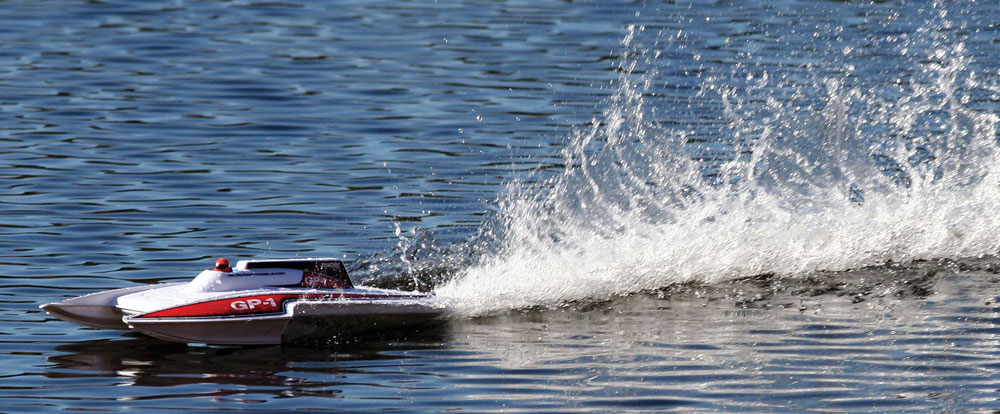
Words and Photos by Jerry Dunlap
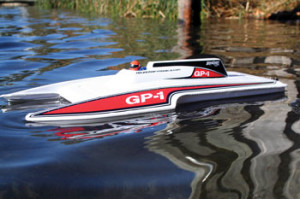
MINI SIZE – MAXI FUN
The GP-1 from AquaCraft Models is the latest RTR fast electric model developed by AquaCraft’s chief designer, Mike “Grim Racer” Zabrowski. Measuring 16 1/2 inches, this pickle fork, 3-point hydroplane design features performance engineered components. Let’s take a look at what is under the GP-1’s cowling and attached to the hull.
AT A GLANCE
MANUFACTURER: AquaCraft
WHO IS IT FOR: Novice to experienced boaters
HOW MUCH: RTR $180, RxR $140
BUILT TYPE: RTR
BOAT TYPE: 3-point hydroplane
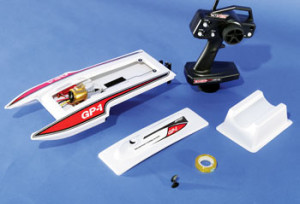
SPECS
ELECTRIC 3-POINT HYDROPLANE HULL
HULL LENGTH: 16.4 in.
OVERALL LENGTH: ???
BEAM: 8.8 in.
HEIGHT: 4 in.
HULL MATERIAL: ABS Plastic
WEIGHT: 14.4 oz.(less battery pack)
– MOTOR
TYPE: 2200Kv inrunner brushless marine motor with water cooling motor jacket
DIMENSIONS: 28X35mm
SHAFT DIAMETER: 3mm
– ESC
Water-cooled LiPo-compatible 30A brushless with Deans Ultra-Plug connector
Input voltage 8 – 14V
Max Surge Current 28A/15 seconds
– RADIO GEAR
TYPE: Tactic TR324 3-channel 2.4GHz
RECEIVER: Tactic TR324 3-channel 2.4GHz
SERVO: ???
– PROP: 30mm diameter FRP (fiber reinforced plastic)
– RUDDER/STRUT: FRP
– DRIVE SYSTEM: Wire drive with steel prop stub shaft
NEEDED TO COMPLETE
• 3S LiPo pack 1000 – 1300 mAh 30C or higher
• 4 “AA” batteries for transmitter
• Highly recommended – Grim Racer Pro radio box tape
TOOLS/SUPPLIES NEEDED
• A 2mm hex wrench for the cinch coupler
• Grease for drive system – Grim Racer Speed Grease used by author
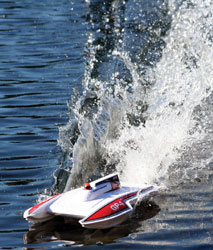
RUNNING HARDWARE
The GP-1 is the first RTR model boat to feature a wire drive system. Wire drive systems provide less drag than a cable or straight shaft drive system. A double set screw cinch motor coupler connects the wire drive to the 2200Kv inrunner brushless marine motor. The wire drive should be removed after a day of running and the drive system greased. After greasing and reinserting the wire drive into the drive tube, it was necessary to push the motor/coupler downward slightly to align the wire drive to the coupler. Necessary maintenance steps are thoroughly covered in the very complete pictorial instruction manual. A water-cooling jacket provides cooling to the motor. The water cooled, LiPo-compatible ESC is rated at 30 amps. Deans Ulta Plug connectors mate a 3S(1000 – 1300 mAh) battery pack to the ESC. The rudder and strut assemblies are formed from fiber reinforced plastic(FRP). The strut is adjustable and the rudder features an o-ring break-away system. However, it would appear it would take a pretty solid hit to cause the o-rings to release the rudder. The FRP propeller is a 30mm diameter that is used on several other AquaCraft RTR models.
HULL
The hull and cowling are constructed from molded ABS plastic. The extended flange construction technique provides a secure joining of the top and bottom hull parts. Plastic ride strips are attached to the sponson bottoms providing sharp edges to sheer the water off the sponson. The receiver is wrapped in a balloon and tucked under the right side of the hull. The ESC is located under the left side of the hull. The cowling is held in place by two dowel pins in front and strong magnets in the back. To prevent water from gaining access to the hull while running, waterproof tape is applied to seal the cowling to the hull. Running the boat without sealing the cowling to the hull will result in a considerable amount of water accumulating in the hull. A drain hole is located in the right side of the transom to facilitate draining water in the hull. I immediately misplaced or dropped the black transom drain plug onto a blacktop parking surface after the first run. A simple fix was inserting a ½-inch, 4-40 screw into the drain hole. The 4-40 screw seals the drain hole, releases easily, and I have an abundant supply. Paper towels can be used to soak up any water remaining in the hull after draining. Water tends to cling to the plastic even after shaking the hull. A blow-dryer set on low heat can be used after a day of running to get any remaining moisture out of the hull.
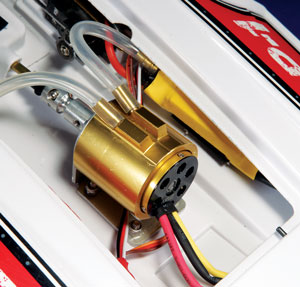
The graphics are factory applied. A problem with applying a flat graphic decal to a curved surface is the edge wrinkle in the decal. A simple fix is to take a #10 hobby blade or a single edge razor and carefully cut a slit in the wrinkle. Once the decal has been slit it can be pressed tight against the hull. I painted the diver helmet orange and the cockpit area dark blue to enhance the scale appearance of the boat. In limited racing, GP is the class designation for Grand Prix Hydroplane. The GP class is just below the Unlimited Class in size and speed. GP Class Hydroplanes are powered by big block V-8 automotive engines.
ELECTRONICS
The GP-1 RTR is controlled by a Tactic TTX240 2.4GHz radio system. The transmitter provides steering and throttle trim, steering and throttle servo reversing, and steering rate adjustment. A Hobbico mini servo provided rudder control. I have used this radio system in my Sport 20 Hydroplane and 20 Outboard Hydroplane without any problems. I was using a more powerful servo for rudder control. Additional receivers for the TTX240 are $22.
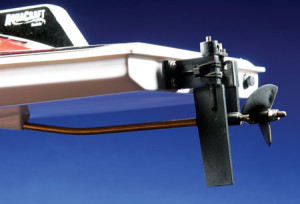
PROS
+ Quality, performance running hardware
+ Brushless 2200Kv inrunner motor and water-cooled ESC
+ Scale appearance with factory applied graphics
+ Attention grabbing performance
+ Comprehensive instruction manual
CONS
– Radio box sealing tape included in kit
– Wrinkles in decals – see article for easy fix
– Plug for transom water hole – see article for easy fix
DOCKSIDE DEDUCTIONS
It doesn’t take much to get the RTR version of the GP-1 ready for a trip to the lake. Stick four “AA” batteries into the transmitter, charge a 3S LiPo pack, and it’s time to load up and head to the lake. A method to retrieve the boat needs to be included. The GP-1 is small, fast and reacts quickly to water conditions. I discovered how quickly the boat reacts on the very first launch. Actually, it was the second attempt to launch the boat. For my first launch, I placed the GP-1 in the water and applied throttle. The boat did not want to get on step. I returned the boat to shore and gave it a slight toss to get it on step. I applied full throttle and headed straight out. After about 200 feet of straight running, I attempted to make a gradual full speed right turn. The boat immediately flipped over. The application of rudder and a slight chop out on the lake brought the rowboat out of my truck. An inverted GP-1 has very little surface area for the wind to catch and blow the boat close to shore.
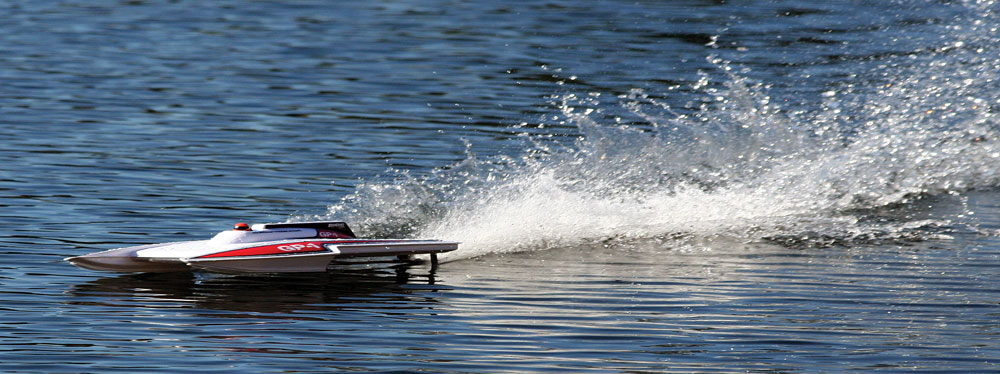
Once the GP-1 was returned to the beach, I opened the hatch to check for any water in the hull. There was a little water, but not all that much considering the boat had been upside down for at least five or six minutes. I also reduced the amount of rudder throw using the rudder rate dial on the transmitter. The cowling was again taped to the deck with Grim Racer Pro Radio Box Tape and the GP-1 launched for its second run. This time I slowed down slightly before applying rudder control. Along with the reduced rudder throw, this adjustment eliminated any further incidents of the boat flipping in a corner. I stopped the boat on the water to see how it would get back on step. Gradually increasing power and applying left rudder proved successful. My eyeball radar showed the GP-1 running in the low- to mid-20s. Run times were four to five minutes. The ESC has a low voltage “bump” feature, causing the GP-1 to hesitate slightly while running. To avoid damaging the LiPo pack, the boat should be returned to the beach once the “bump” is observed.
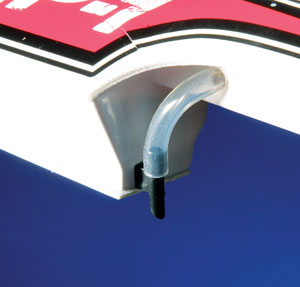
WRAP UP
The GP-1 packs exciting performance in a small package. For a boat this size, the GP-1 has the speed potential to run “on the edge” and “over the edge.”For a novice model boater, the GP-1’s scale-like appearance, premium parts and attention-grabbing performance deserves consideration. However, since the GP-1 is capable of reaching “splish, splash, flip” speeds, a retrieval method other than swimming after it with a personal floatation device (PDF) is essential. It may seem I have overly stressed the importance of retrieving the boat. There have been instances making national news where people have drowned when swimming after a stalled model boat. Have fun and play safe.
LINKS
Aquacraft, aquacraftmodels.com, (217) 398-8970
 RC Boat Magazine The World's Leading Radio Control Boating Magazine
RC Boat Magazine The World's Leading Radio Control Boating Magazine
